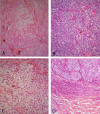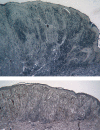Non-choroidal yellow melanoma showing positive staining with Sudan Black consistent with the presence of lipofuscin: a case report
- PMID: 24855574
- PMCID: PMC4029254
- DOI: 10.5826/dpc.0402a09
Non-choroidal yellow melanoma showing positive staining with Sudan Black consistent with the presence of lipofuscin: a case report
Abstract
A case of a predominantly yellow primary superficial spreading melanoma arising on the back of a 44-year-old woman is presented. Possible causes of the clinical and dermatoscopic yellow color are discussed. Staining with the histochemical stain, Sudan Black, revealed a differential uptake compared to a closely matched control melanoma. We speculate that the clinical and dermatoscopic yellow color could be due to the presence of increased amounts of the pigment lipofuscin, which is known to produce subtle orange color in some choroidal melanomas.
Keywords: Sudan Black; dermatopathology; dermatoscopy; dermoscopy; hypomelanotic melanoma; lipofuscin; yellow melanoma.
Figures







Similar articles
-
Retinal and pigment epithelial alterations over choroidal malignant melanomas.Ann Ophthalmol. 1975 Apr;7(4):487-9, 491-2. Ann Ophthalmol. 1975. PMID: 50039
-
Role of In Vivo Reflectance Confocal Microscopy in the Analysis of Melanocytic Lesions.Acta Dermatovenerol Croat. 2018 Apr;26(1):64-67. Acta Dermatovenerol Croat. 2018. PMID: 29782304 Review.
-
Amelanotic/Hypomelanotic melanoma--is dermatoscopy useful for diagnosis?J Dtsch Dermatol Ges. 2003 May;1(5):369-73. doi: 10.1046/j.1610-0387.2003.02042.x. J Dtsch Dermatol Ges. 2003. PMID: 16285302
-
Dermatoscopy of amelanotic and hypomelanotic melanoma.J Dtsch Dermatol Ges. 2014 Jun;12(6):467-72. doi: 10.1111/ddg.12368. Epub 2014 May 14. J Dtsch Dermatol Ges. 2014. PMID: 24825465 Review.
-
Autofluorescence of orange pigment overlying small choroidal melanoma.Retina. 2007 Oct;27(8):1107-11. doi: 10.1097/IAE.0b013e31814934ef. Retina. 2007. PMID: 18040254
Cited by
-
Lipofuscin, lipofuscin-like pigments and autofluorescence.Eur J Histochem. 2015 Feb 6;59(1):2485. doi: 10.4081/ejh.2015.2485. Eur J Histochem. 2015. PMID: 25820564 Free PMC article. Review.
-
Cell autofluorescence and lipofuscin.Front Med (Lausanne). 2015 Feb 19;2:6. doi: 10.3389/fmed.2015.00006. eCollection 2015. Front Med (Lausanne). 2015. PMID: 25745630 Free PMC article. No abstract available.
References
-
- Rosendahl C, Cameron A, McColl I, Wilkinson D. Dermatoscopy in routine practice—“Chaos and Clues.”. Aust Fam Physician. 2012 Jul;41(7):482–7. - PubMed
-
- Chamberlain AJ, Fritschi L, Kelly JW. Nodular melanoma: patients’ perceptions of presenting features and implications for earlier detection. J Am Acad Dermatol. 2003 May;48(5):694–701. - PubMed
-
- Moloney FJ, Menzies SW. Key points in the dermoscopic diagnosis of hypomelanotic melanoma and nodular melanoma. J Dermatol. 2011 Jan;38(1):10–5. - PubMed
-
- Kittler H. Dermatoscopy: introduction of a new algorithmic method based on pattern analysis for diagnosis of pigmented skin lesions. Dermatopathology: Practical & Conceptual. 2007;13:3.
Publication types
LinkOut - more resources
Full Text Sources
Other Literature Sources
